#wednesday image
Text

happy crash wednesday
#crash 1996#james spader#david cronenberg#my art#missed the opportunity on actual ash wednesday so. making up for it#girl your gaze haunts me ....#also finally glazing my art. didnt realize itd take so long tho 😭#took like an Hour for one image. my cursed mac
2K notes
·
View notes
Text

Sparkle on! It’s Wednesday! Have fun and be yourself! 🌟💫
#HAPPY WEDNESDAY#pease and love in the quadrant#I love this image of sisko so much#sparkle on!#star trek#ds9#star trek ds9#benjamin sisko#captain sisko#ben sisko#silly#tw flickering#Flashing
3K notes
·
View notes
Text
Wet Beast Wednesday: moray eels
This week on Wet Beast Wednesday I'll be going over something amazing, a fish with a sense of morality. You see, the moral eel is known for, what... I think I'm reading this wrong. Oh, MoRAY eel, not moral. Well this is awkward. Hang tight, I need to go redo my research.

(Image: a green moray (Gymnothorax funebris) swimming outside of its burry, with its whole body visible from the side. It is a long, slender fish that looks a bit like a snake. A long fin starts just below the head and continues down the length of the body. The body is arranged in a wave pattern. It has a pointed snout and small eyes. Its body is a yellow-green color. In the background is the sandy seafloor, dotted with various sponges and corals. End ID)
Moray eels are true eels, meaning they are in the order Anguiliformes. Yeah, I did wolf eels, electric eels, and lamprey eels before I got around to actual eels. There are over 200 known species of moray eel in 15 genera. Like other eels, they are elongated bony fish with extra vertebrae and reduced fins. Moray eels have fewer fins than most eel species, only having a dorsal, anal and tail fin that merge together and run down the back of most of the body and underneath portion of it. They achieve motion by undulating this long fin and sometimes undulating the rest of the body as well. Moray eels aren't the fastest of fish, but they can swim backwards, something almost no fish can. The head has a long snout with wide jaws. Most species have long fangs used to grab onto prey, but a few species are adapted to eat hard-shelled prey and have molar-like teeth to crush through shells instead. Probably the coolest feature of morays are the pharyngeal jaws. This is a second set of jaws located in the back of the mouth. When the eel bites onto prey, the jaws can be shot forward to grab the food and help pull it into the throat. While lots of fish have pharyngeal jaws, morays are the only ones who can extend their pharyngeal jaws forward and use them to grab prey. Morays have smooth, scaleless skin that is often patterned to provide camouflage. The skin is coated in mucus that provides protection from damage and infection. In some species, the mucus can be used to glue sand together to help reinforce burrows. Morays lack lateral lines, a system of organs found in most fish that senses changes in water movement. Their sense of smell is their primary sense. The size of morays varies between species. The smallest species is the dwarf moray eel (Gymnothorax melatremus) which reaches 26 cm (10 in) long. The largest species by mass is the giant moray eel (Gymnothorax javanicus) which can reach 3 meters (10 ft) and 30 kg (66 lbs) while the longest species is the slender giant moray (Strophidon sathete), the longest known specimen of which measured in at 3.94 m (12.9 ft).

New reaction image
(Image: a giant moray (Gymnothorax javanicus) emerging from a burrow. It is brown and mottled with yellowish patches. Its head is pointed at the camera and it's mouth is wide open, aming it look shocked. End ID)

(Image: an anatomical diagram of the skeleton of a moray eel emphasizing the pharyngeal jaws and the muscle attachments. End ID. Art by Zina Deretsky)
Moray eels are found throughout the Atlantic, Pacific, and Indian oceans. Different species are found in different temperatures and depths, though most species live in relatively shallow, warm water. Several species can live in brackish water and a few will swim upriver and live for a time in fresh water, though there do not appear to be any species that live their entire lives in fresh water. Morays are ambush predators who rely on the element of surprise. They live in small, tight places such as holes in coral, gaps between rocks, or sandy burrows. When prey passes, the eel can lunge out and grab it. Unlike most fish, the eel cannot use suction feeding due to the shapes of their mouths. They have to rely on lunging froward and catching prey with their mouths. Their mouths are adapted in shape to push water to the sides. This reduces water resistance and avoids creating a wave that could push prey away from the eel. If an eel catches prey that cannot be swallowed whole, it will tie itself in a knot while biting on to the food. By pulling its head through the loop, the eel can rip the food into bite-sized pieces. Spending most of their times in burrows also provides protection from predators, especially in juveniles or smaller species. At night, the eels will come out of their burrows to hunt sleeping prey while the larger predators are asleep. Giant morays have also been seen engaging in interspecies cooperative hunting with roving coral groupers (Plectropomus pessuliferus). The eels can fit into small crevices the groupers can't to flush prey into the grouper's path while catching their own. Morays are mostly solitary species and many can be territorial. They are known to be shy and will retreat into their burrows if they feel threatened. They are also curious and many species are quite intelligent.
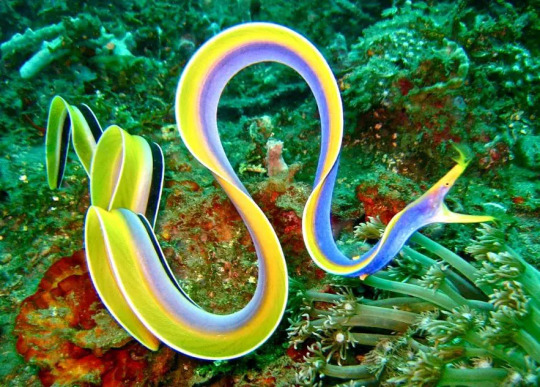
(Image: a male ribbon eel (Rhinomuraena quaesita) on a coral reef. It is a very long and slender eel with its body curved in many waves. It is brightly colored, with a blue-purple body, yellow fin and face, and a long black and white stripe running down the back half of the body. On the nostrils are two feather-like structures. End ID)
Morays reproductive strategies are poorly known and differ based on species. While many species seem to have no set mating season and will reproduce whenever they can, others will mate at the same time every year. Some species seem to have dedicated spots to lay their eggs and a few are believed to be anadromous, meaning they travel from the sea to fresh water to spawn. Meanwhile, some of the species that spend a lot of time in fresh water are catadromous, meaning they return to sea to mate. Females will lay their eggs and the male fertilize them. After this, they depart, providing no parental care. As with all true eels, moray eels begin life as leptocephalus larvae. This type of fish larvae is notable for its resemblance to a simple, transparent leaf with a head on one end. These larvae are unique and poorly understood, despite being the larval stage of a lot of different species of fish. They are unusually well developed for larvae, capable of active swimming and generally living life. In fact, some particularly large leptocephalus larvae were initially mistaken for adult fish. They feed mostly on bits of drifting organic material called marine snow and can remain in the larval stage for up to 3 years, with those in colder conditions usually taking longer to metamorphose. All leptocephalus larvae start out with no sex organs, then develop female organs, then develop male ones, becoming simultaneous hermaphrodites. They will ultimately become eith male or female and it is likely that environmental factors are the main determining factor. During metamorphosis into a juvenile, the leptocephalus can reduce in size by up to 90%, resulting in the juvenile being smaller than the larva. The process of maturation is poorly understood, but it seems that most morays will be sexually mature by three years of age.

(Image: multiple photos of a particularly large leptocephalus larva (not sure what species). It is a translucent organis, wth a body shaped like a very long leaf, narrow at both ends. In the frint is a very tiny head. End ID)
Morays are shy and generally avoid humans. Though some cultures have hunted them for food, they are often not considered a particularly good food source. Many species have high levels of chemicals called ciguatoxins in their bodies, which can lead to a condition called ciguatera fish poisoning if eaten. The largest threat to morays is habitat loss. This is especially true for the many species that live in coral reefs, which are in increasing danger due to global warming. Attacks on humans are rare and usually happen as a response to a human sticking their hand in the eel's burrow. Some of the large species could cause significant damage with a bite. Some species, usually the smaller ones, are found in the aquarium trade, thought they are not good pets for beginners as even the smallest morays are still large for aquarium fish and have some specific requirements. The curiosity many morays have has led to some becoming familiar with and even friendly to humans, often the result of feeding them. They can recognize individual humans and remember them over the course of years. Aquarium employees sometimes report that the eels will come to nuzzle and play with them and have personalities like dogs. Marine biologists and professional SCUBA divers Ron and Valorie Taylor befriended a pair of eels they named Harry and Fang at the Great Barrier Reef who would remember them and come out to visit them year after year.
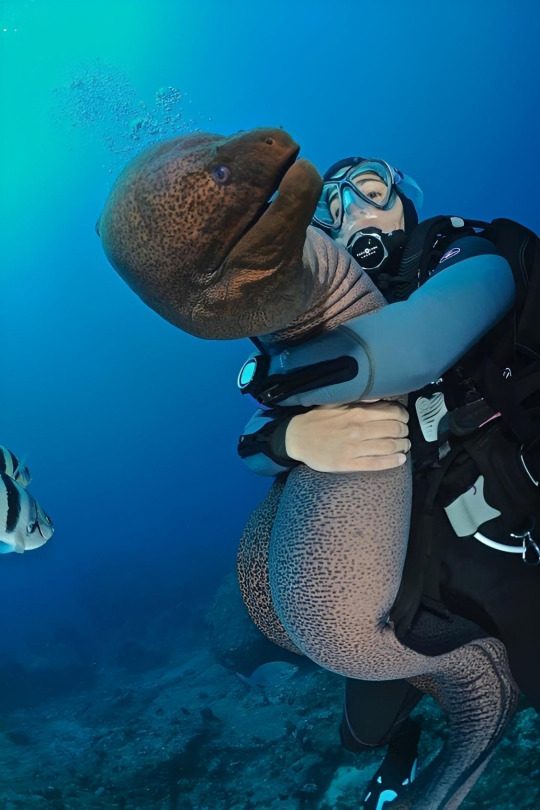
(Image: a SCUBA diver hugging a large, brown moray with black spots. End ID)
youtube
(Video: A shot video showing Valeria Taylor and a moray eel she befriended)
youtube
(Video: the song "That's a Moray", a parody of the song "That's Amore" by Dean Martin)
#wet beast wednesday#i accidentally typed moron eel more than once#moray eel#eel#anguiliformes#fish#bony fish#fishblr#fishposting#eelposting#marine biology#biology#ecology#zoology#animal facts#informative#image described#that's a moray#educational#Youtube
686 notes
·
View notes
Note
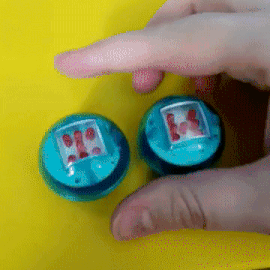
ah, i finally caught a weird dice wednesday (apologies for the gif quality, i had to crunch it down to fit)
I got these electronic d6s from Target as a child, at least 15 years ago, and the batteries are still kickin, they refuse to die
not pictured is the awful little beeping noise they make while "rolling"
2K notes
·
View notes
Text


#I was thinking about this image again and thought of these two#wednesday#wednsday addams#Wednesday Netflix#enid sinclair#wenclair#top posts
2K notes
·
View notes
Text


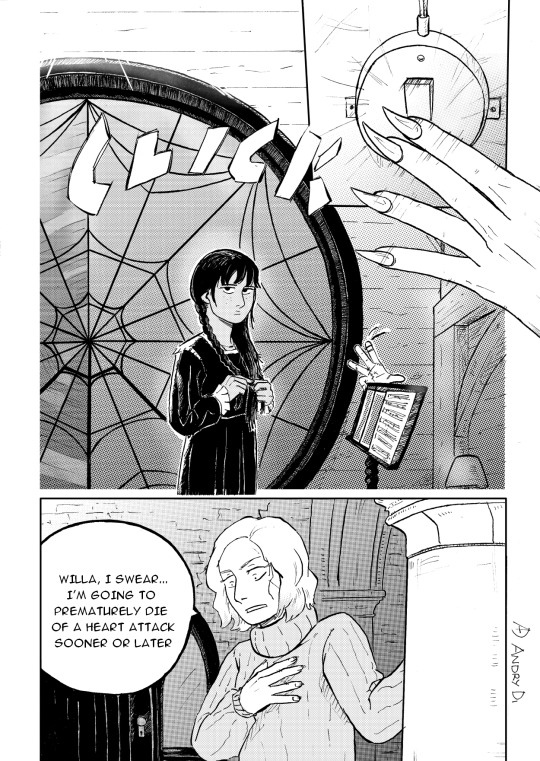




#wednesday#wednesday addams#enid sinclair#bianca barclay#yoko tanaka#divina#kent#wenclair#yokovina#comics#myart#I had to lower the quality of the comic images because one of them was over 7 mb#Don't get used to this insane number of posts per month
3K notes
·
View notes
Text
Enid: Wednesday, go apologize to Thing or I won't help you.
Wednesday:
Enid:
Wednesday: Yes, querida.
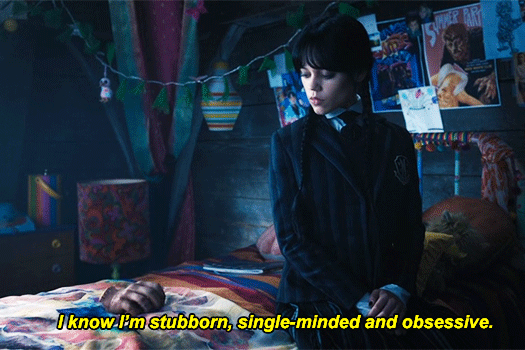
Enid: Wednesday, I made a black cat costume for you.
Wednesday:
Enid:
Wednesday: Yes, querida.
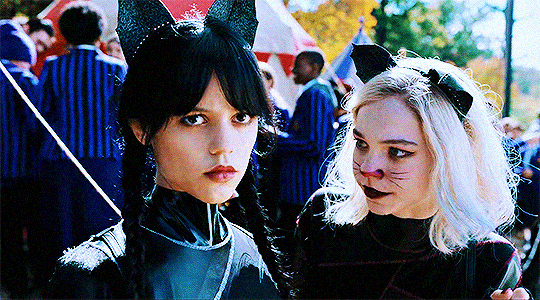
Enid: Wednesday, I made us matching snoods!
Wednesday:
Enid:
Wednesday: Yes, querida.

Enid: Wednesday, please get rid of your creepy crime board.
Wednesday:
Enid:
Wednesday: Yes, querida.

Enid: Wednesday, please hold me in your-
Wednesday: Yes, querida.

#I'll never get over the mental image of Wens storming across campus with her crime board under one arm and the stand under the other#like that's hysterical to me because she is so small and her board so big but her wife told her NO#Enid says Jump and Wednesday says How high?#like the epitome of whipped#protecting Enid's feelings over the snood#agreeing to join the black cats#telling her about nero???#down bad for the wolf#wenclair
258 notes
·
View notes
Text
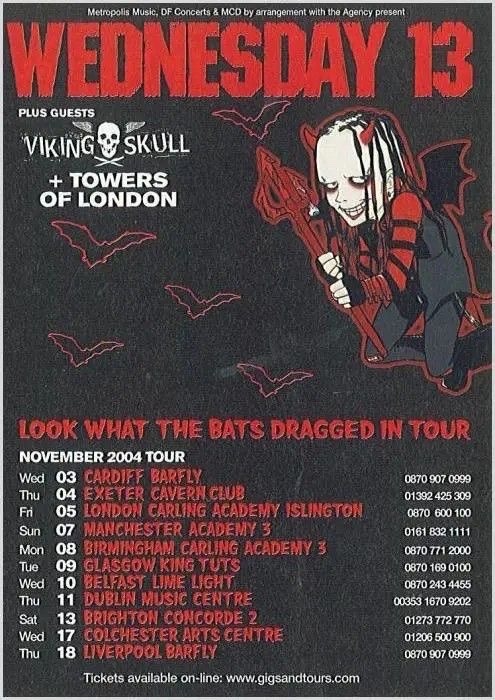
#2000s bands#early 2000s#2000s mall goth#not my image#murderdolls#wednesday 13#mall goth#horror punk#goth#punk#rock#joseph poole#bats#red and black#tour#concert
205 notes
·
View notes
Text

No context Dire Werehog
#It’s part of a bigger thing#sonic the hedgehog#sonic unleashed#sonic the werehog#sth#werehog#Man Meme#The editor I used crunched the fuck outta my image#steamed doodles#silly#werehog wednesday
411 notes
·
View notes
Text




HAPPY VALENTINES DAY!! <3
Wanted to draw a bunch of different pairings so here we go!! I wanted to draw them on how I imagine their dates with each other would go.
Fred and Shaggy started out on a walk but halfway through Fred saw a place they caught a bad guy once and started reminiscing on their good times spent together and who is Shaggy to complain, they definitely went to get food after it though.
Daphne and Fred went to a screening at the Coolsville local cinema where they were showing one of the first ever 3D movies. When the movie is over Fred spends the rest of their date talking about how impressive the improvements to 3D films have been since they were first invented. Daphne doesn't mind that much since she still gets to cuddle and they also probably went to get food after it where Daphne assigns their friends roles in the movie they just watched.
Shaggy and Daphne went to a football game where Shaggy gets to eat very many football game foods such as Hotdogs and whatever else they eat at football games. Daphne isn't even rooting for a team cause at first she wasn't sure about going but it hits halftime and she's caught up in the atmosphere and uses the celebration of any of the teams scoring as an excuse to kiss Shaggy.
Velma and Daphne are working on very important mystery solving and journalism career things on their laptops so they don't have time to go on a date date HOWEVER that will not stop them from flirting through messages as they work. Daphne sends Velma things like videos and songs that remind her of her and Velma can't flirt back so she just sends hearts like a disaster lesbian, good for her tbh.
#scooby doo#scooby doo fanart#my art#fraggy#fraphne#shaphne#vaphne#mystery incorporated#fred jones#shaggy rogers#daphne blake#velma dinkley#mystery polycule#I'm posting this a day early cause I have plans on wednesday#PLEASE IGNORE THE FACT THE LINEART LOOKS A BIT CRUNCHY BEFORE YOU CLICK ON THE IMAGES I CANT FIX IT#AND I SPENT TOO LONG ON THESE TO NOT POST THEM IM SO SAD#why would clip studio's ink brushes do this to me?!!? Really let me down in my time of need wtf#also I think you can tell I like drawing Shaggy the most I think#well actually i enjoy drawing them all#also I'm very attached to the concept of adrenaline junkie Daphne i'm so sorry#daphne is in three out of the four of these good for her#also 13 ghosts shaggy vibes because im nothing if not a 13 ghosts shaphne girlie#i actually dont even have a favourite scooby ship im fine with most of them tbh#and by fine I mean so very not normal about fraphne and shaphne specifically like you don't get it#and since i didn't include scooby i added silly little scooby details like shaggy's socks#and daphnes nail polish colour and her headphones logo#so normal about this franchise i swear
281 notes
·
View notes
Text

Super Mario Bros won my last fanart poll! So here is big brother Mario taking little brother Luigi out for some Raccoon Tail Flying Lessons.
#super mario brothers#super mario bros#mario#luigi#mario and luigi#art#jenstoart#if you want to see a video of me painting this pic sub to my patreon#the time lapse will go live next month sometime but the real time will always be patron exclusive#also for those who sub this sketch was a work in progress wednesday image from last year! So they got a preview of that too#not all wipwed pics get the painting treatment but I always intended this one too sooner or later#glad it won the poll
180 notes
·
View notes
Text

Sink your teeth into the 🍉🇵🇸🍉 Wet Beast Wednesday 🍉🇵🇸🍉 spirit!
#🍉🇵🇸🍉🇵🇸#Wet polar beasting#wet beast wednesday#free palestine#we will admit#perhaps not the best image of the 🍉#but a fine image of a snorfing fine wet polar beast
168 notes
·
View notes
Text

#yennaia#rhaenicent#wenclair#rhaenyra x alicent#yennefer x tissaia#wednesday x enid#hotd#the witcher#wednesday#yennefer of vengerberg#tissaia de vries#alicent hightower#rhaenyra targeryan#wednesday addams#enid sinclair#non canon#non canon ships#supercorp#jackieshauna#adding these cuz i saw someone comment supercorp and i was like true i may not have included them as an image but theyre always with us
883 notes
·
View notes
Text
Wet Beast Wednesday: parrotfish
Which fish hangs out on a mermaid pirate's shoulder and repeats what she says in a high-pitched voice? The parrotfish, of course. Or at least in fiction they should (certainly will in my D&D world). But even in real life, parrotfish are still pretty interesting.

(Image: a common parrotfish (Scarus psittacus) seen from the side in front of rocks and corals. It is a brightly-colored fish, mainly light blue but with patches and stripes of yellow and pink on the fins. Its mouth is open, revealing what appears to be a beak. End ID)
Parrotfish are fish famous for their mouths and eating habits. There are about 90 species known. While they were historically considered their own taxonomic family, they have since been reclassified a subset of the wrasse family and there is still some debate on how to classify them. Most species are on the smaller size, but a few can get very large. The largest species is the green humphead parrotfish (Bolbometopon muricatum) at 1.5 meters (4.9 ft) and 75 kg (165 lbs) while the smallest species is the bluelip parrotfish (Cryptotomus roseus) reaching 13 cm (5 in). I could not find an average weight for the bluelips. What makes parrotfish really stand out visually is their colors and their mouths. Most species are very brightly colored, with distinct markings and males are usually more brightly colored than females. Their mouths are dominated by what appear to be beaks, which gave them their common name. These beaks are actually made of approximately 1,000 teeth arranged in 15 rows. As the teeth wear out, they drop off and are replaced by the row behind them. The teeth are made of fluorapatite, the second hardest biomineral int the world. To support their hardness, the fluorapatite crystals that make up the teeth are woven together in a structure very similar to chainmail, resulting in very hard teeth that measure in at a 5 on the Mohs scale of hardness. For reference, iron is a 4 and higher numbers are harder. The teeth can also handle 530 tons of pressure. You could put the weight of 200 black rhinos on a tooth and it would be fine. The beaks are powerful enough to bite through rock. Which is what they use it for, but more on that below. Another unusual feature of parrotfish is how they sleep. Some species make their own sleeping bags, which would be adorable if they weren't made of mucus. The mucus is produced using glands in the gills and looks like a transparent bubble. The fish sleeps in the mucus cocoon and when it wakes up, it eats the cocoon. There have been several proposed benefits of the cocoon. It contains chemicals that harm skin parasites while also providing a barrier that keeps new parasites from reaching the fish. It also likely blocks the fish's scent, helping it hide from predators.
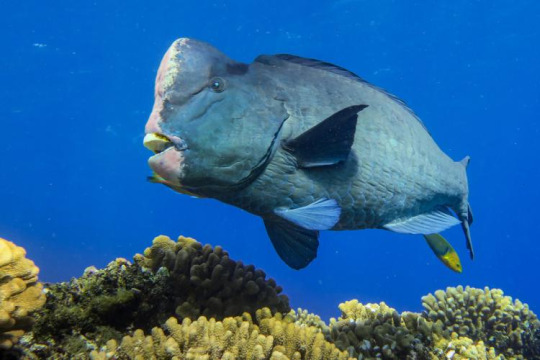
(Image: a green humphead parrotfish (Bolbometopon muricatum) swimming over yellow coral. It is large and mostly a uniform green color, except for the front of its head, which is pink. It has a large, fleshy lump on the top of its head. End ID)
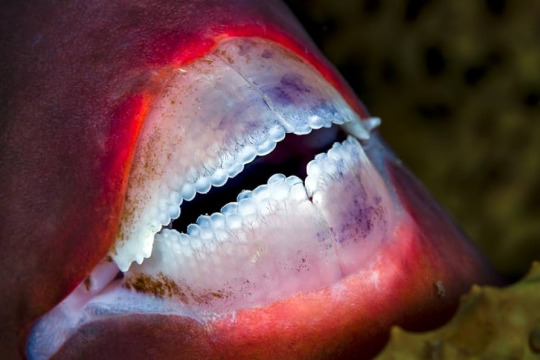
(Image: a close-up of a parrotfish's beak. The top and bottom beaks are divided into two halves, left and right. The beak is bade of small, circular teeth that overlap each other. End ID)
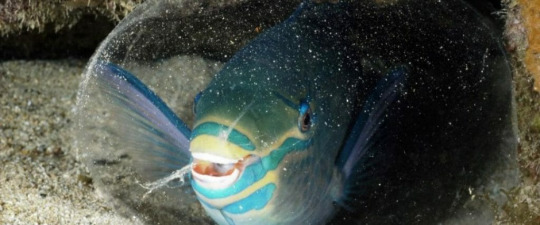
(Image: another common parrotfish seen from the front. It is inside of a mucus cocoon, which appears as a transparent bubble around the fish. Bits of sand dot the cocoon's surface. End ID)
Parrotfish live worldwide, though the majority of species are found in the Indo-Pacific. They live in warm, shallow waters with lots of rocky reefs, especially coral reefs. They use those powerful teeth to eat and what they eat most is algae. There are three main types of feeding behavior: excavating, scraping, and browsing. Excavators bite into rocks to get their food, scrapers crape food off of the surface of the rocks, and browsers go after larger food sources like seagrass and sponges. Some of the larger parrotfish species also make coral a large part of their diet. When they eat, they naturally get rock in their mouths, moreso in excavators. Because their food clings to the rock, spitting the rocks out would deny them food. Instead, parrotfish use pharyngeal teeth set in their throats to grind the rock into sand, which then passes through the digestive tract. When it exists the digestive tract, it is in the form of fine grains of rock. Or to put it another way, parrotfish eat rock and poop sand. A single parrotfish can produce up to 40 kg (88lbs) of sand yearly, and bigger species can produce even more than that. The process of rock being broken down by living things is called bioerosion and parrotfish are one of the most famous sources of bioerosion. The sand they produce can serve as the basis for new growth of coral or other species and helps reinforce nearby islands. In places like Hawai'i, the Caribbean, and the Maldives, it's estimated that up to 80% of the famous white sand is produced by parrotfish and they serve as a major source of incoming earth to support the islands. This makes parrotfish ecosystem engineers. Their eating of algae is also majorly important to their ecosystems. Algae can overgrow and smother delicate ecosystems like coral reefs and seagrass beds and decaying algae draws oxygen out of the water. Parrotfish help the health of their environments by keeping the algae population at healthy levels. Parrotfish also eat seaweeds and sponges that grow much faster than coral and can smother coral reefs. Parrotfish are considered keystone species in many reefs, including the great barrier reef and their population dropping correlates with reduced health of reefs. Damaged reefs tent to have larger parrotfish populations and those populations drop as the reef recovers.

(Image: a group of many parrotfish feeding on coral. They are all the same species and are mostly blue, with yellow heads and stripes on the face. They appear to be biting the the coral. End ID)
Parrotfish are protogynous sequential hermaprodites. This means that all parrotfish are born female and can become male later in life. The transition is usually triggered when there are too many females or not enough males in a location, though in some species any fish that reaches a certain size will become male. Some parrotfish are solitary while others are social. In social species, the social groups consist of a large male and a harem of females that he protects and claims mating rights with. Other males will attempt to fight the male for dominance via headbutting and threat displays and occasionally one of his harem members will become male to challenge him. Males are usually more colorful than females, which they use to woo females, but also puts them at greater risk of predation. If the harem leader dies and is not replaces, one member of the harem will transition to male and replace him. Many species perform courtship dances during nights of the full moon. In non-social species, males will perform displays and fight with each other to attract females. In social species, the dominant male will mate with his harem while smaller males without harems will try to sneakily woo claimed females or sneak in and mate without being noticed. Parrotfish are broadcast spawners. The female releases her eggs into the water and the males releases sperm to fertilize them. The eggs will drift on the current until settling, after which the larvae will hatch. As with most fish species, only a very few of the larvae will reach adulthood.

(Image: a Mediterranean parrotfish (Sparisoma cretense). It is mostly bright red, but with a yellow patch above the tail and a yellow stripe around the eye that runs down to the belly. A large patch behind the eye is blue. End ID)
Thankfully, most parrotfish species are not particularly endangered. The largest threat to them comes from habitat loss as pollution and climate change harms coral reefs. Reintroducing parrotfish to damaged reefs helps them recover. All species are edible, though there is no commercial fishery for them. While parrotfish are capable of delivering powerful bites, there are few reports of humans getting bit. That being said, I found one case where someone had skin on his penis bitten off by a parrotfish. And yes, that link has pictures. Enjoy.

(Image: a blue parrotfish (Scarus coeruleus) looking at the camera. It is a blue fish with darker patches around the eye. Its snout is bulbous and the beak points downward. End ID).
#wet beast wednesday#parrotfish#the smiling grinner#fish#fishblr#fishposting#marine biology#biology#zoology#ecology#animal facts#coral reef#penile trauma#that's a wild tag to have on a post about fish#informative#image described
361 notes
·
View notes
Note
Biggest dice you have?
rainbow metal d100

#weird dice wednesday#this is the product image it's 6 in the morning i can't be arsed to open tumblr on my phone
974 notes
·
View notes
